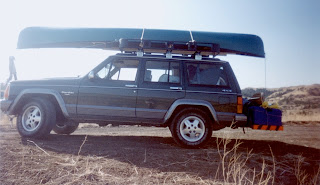This morning I downloaded, from Academia.edu, a paper titled, "Ethnohistory and Euro-American Contact in Missouri" by W. Raymond Wood.
I often download research papers in hopes I'll find some additional details about one of our voyageur ancestors.
This morning I found a nugget... from 1700 July 13, by French fur trader and explorer Pierre-Charles Le Sueur, who commented that Missouri means “canoe,” so named for the Indians who are called the “peoples of the canoes.”
Being an old guy, 78 next month, it doesn't take much to trigger pleasant memories of a bygone time.
"What Has Been Will Always Be" is a quote about Memory that I dearly love.
Missouri means “canoe,” got me to reminiscing about a 1995, 150 mile long, solo canoe trip down the Upper Missouri River in Montana.
A couple years earlier I met a fellow at the National Finals Rodeo in Las Vegas. We got to talking about canoeing and exchanged phone numbers. He called and said he and a friend were planning a run down the Upper Missouri and I could meet up with them if I was inclined.
We decided on the last week of September, my favorite time for canoe adventures, and agreed to meet at Fort Benton in Montana.
After spending a day with this gent, that I hardly knew, and his buddy I decided I didn't much like being a third wheel, so I bid them adieu, and pushed my canoe into the waters of the Upper Missouri and headed down stream.
A decade earlier in the 1980s, I developed an obsession for reading Montana history and collected books by James Willard Schultz, who spent many years living with Montana's Blackfeet Indians.
One Schultz story, not published until 1979, was "Floating on the Missouri."
It was a boating adventure with plenty of history about the Upper Missouri River. After reading that book I decided someday I had to float the Upper Missouri River in the heart of Montana. The thing that intrigued me most about the Upper Missouri was its historical importance.
Above is Schultz' map of the Upper Missouri River as it appeared in the early 1900s.
Significant historic sites exist around almost every bend of the river
There are at least a dozen Lewis and Clark campsites on the 150-mile wild scenic portion of the river between Fort Benton (my put-in) and the James Kipp Recreational Area (my take-out).
If you are interested in Native American history a lot happened on the Upper Missouri.
Chief Joseph crossed the Upper Missouri at Cow Island in 1877, when he and his Nez Perce people resisted the US Army's attempt to forcibly relocate them to a reservation in Idaho.
There were also several fur trade posts that existed on the Upper Missouri. The best known was the American Fur Company’s Fort MacKenzie.
Steamboat landing sites and abandoned turn-of- the-century homestead buildings still exist, ready to be explored by canoeists.
What I cherish most about my Upper Missouri River Adventure is the incredible wildlife I encountered. The river abounds with ducks, geese, golden and bald eagles, white pelicans, pheasant, coyotes, whitetail deer, bighorn sheep, and an occasional black bear.
With a little imagination one can still see the massive herds of buffalo crossing the river in a Charlie Russell painting.
Unfortunately 1995, was a couple of decades before cheap, waterproof cameras were available, so the few photos I took were with one of those disposable paper box cameras Kodak sold back then.
Still, I have some magical memories of drifting through little canyons in the company of eagles. I can look over my shoulder and visualize a majestic golden eagle suspended a few feet above me as my canoe drifts lazily on the 4 1/2 miles per hour current of the Upper Missouri.
I suspect there’s a lot more traffic on the ol’ river these days, but it’s probably still a worthwhile trip if you love Montana history.
Happy paddling, but keep your eyes pealed for rattlesnakes.






No comments:
Post a Comment